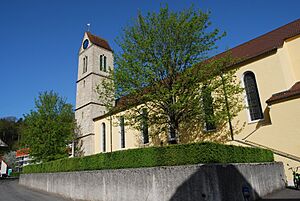Oberbuchsiten facts for kids
Quick facts for kids
Oberbuchsiten
|
||
|---|---|---|
 |
||
|
||
| Country | Switzerland | |
| Canton | Solothurn | |
| District | Gäu | |
| Area | ||
| • Total | 9.39 km2 (3.63 sq mi) | |
| Elevation | 442 m (1,450 ft) | |
| Population
(Dec 2020 )
|
||
| • Total | 2,296 | |
| • Density | 244.52/km2 (633.3/sq mi) | |
| Postal code |
4625
|
|
| Surrounded by | Balsthal, Egerkingen, Holderbank, Kestenholz, Neuendorf, Niederbuchsiten, Oensingen | |
Oberbuchsiten is a small town, also called a municipality, located in the Gäu district of Switzerland. It's part of the Solothurn canton, which is like a state or region in Switzerland.
Contents
A Look Back in Time
Oberbuchsiten is quite old! It was first mentioned in official writings way back in 1040. Back then, it was called vico Buxita. Later, in 1308, it was known as ze Obern Buchsiten.
Exploring the Geography
Oberbuchsiten covers an area of about 9.4 square kilometers (about 3.6 square miles). A big part of the land, almost 38.5%, is used for farming. Even more, about 49.7%, is covered by forests.
About 11% of the land is built up with buildings and roads. A very small part, less than 1%, is made up of rivers or lakes. The town sits at the base of the Jura Mountains. It is located on the alluvial fan of the Mülibach stream.
Understanding the Coat of Arms
The coat of arms for Oberbuchsiten is very simple and meaningful. It shows a green box tree growing from three green hills. All of this is on a golden background. This design is called Or a Box Tree Vert issuant from a Mount of 3 Coupeaux of the same.
Who Lives Here? (Demographics)
Oberbuchsiten has a population of around 2,400 people. Most people in Oberbuchsiten speak German, about 85% of the population. Other languages spoken include Albanian and Italian.
In 2008, about half the population was male and half was female. Many people who live here were also born in Oberbuchsiten or elsewhere in Switzerland. About 15% of the people were born outside of Switzerland.
Age Groups in Oberbuchsiten
Looking at the age of people in 2000:
- About 9.8% of the population were young children (0-6 years old).
- Around 16.5% were teenagers (7-19 years old).
- The largest group, about 34.9%, were adults between 25 and 44 years old.
- About 21.3% were between 45 and 64 years old.
- Around 9.9% were seniors between 65 and 79 years old.
- A small group, 2.3%, were over 80 years old.
Population Changes Over Time
The chart below shows how the population of Oberbuchsiten has changed over many years. You can see how it has grown from just a few hundred people to over a thousand.

Places to See
The entire village of Oberbuchsiten is considered an important cultural site. It is part of the Inventory of Swiss Heritage Sites. This means it has special historical or cultural value.
How People Work (Economy)
In Oberbuchsiten, many people have jobs in different areas.
- A small number of people work in the primary sector, which includes farming and forestry.
- More people work in the secondary sector, like manufacturing and construction.
- The largest number of jobs are in the tertiary sector, which includes services like sales, transportation, restaurants, and healthcare.
Many people who live in Oberbuchsiten travel to other towns for work. About 13.8% use public transportation, while 64% use a private car to get to their jobs.
Beliefs and Religions
Based on a 2000 survey, the main religions in Oberbuchsiten are:
- About 54.8% of the people are Roman Catholic.
- Around 21% belong to the Swiss Reformed Church.
- Some people are Islamic, about 5.3%.
- There are also smaller groups of Orthodox Christians, Christian Catholics, and other Christian churches.
- A small number of people are Buddhist or Hindu.
- About 9.6% of the population do not belong to any church or are agnostic or atheist.
Learning and Education
In Oberbuchsiten, many adults have completed higher education. About 37.5% have finished upper secondary education, and 8.8% have gone on to university or a specialized college (a Fachhochschule).
School System
The school system in the Canton of Solothurn works like this:
- Young children can attend two years of non-mandatory Kindergarten. In 2010-2011, there were 42 children in kindergarten in Oberbuchsiten.
- Students then go to six years of primary school. There were 137 primary school students in the municipality during that school year.
- After primary school, students attend three years of obligatory secondary school. All students from Oberbuchsiten go to secondary school in a nearby town.
See also
 In Spanish: Oberbuchsiten para niños
In Spanish: Oberbuchsiten para niños






